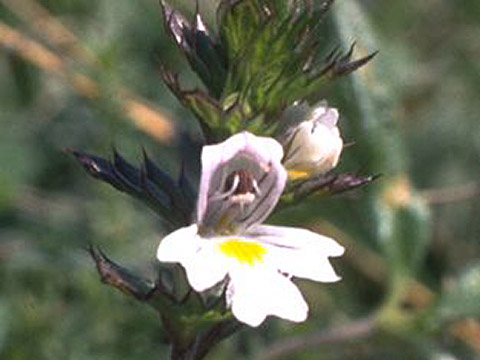Botanical name
Euphrasia officinalis L.
Family
Orobanchaceae (previously classified under Scrophulariaceae)
Common name
Eyebright, Eyewort, Euphrasia
Information about the plant
The genus Euphrasia, with 100 to 250 species, is systematically challenging to record and is organized into various sections and subsections. The medicinally used eyebright, E. officinalis L., represents a complex of species consisting of various closely related taxa (e.g. E. rostkoviana, E. stricta among others). Therefore, it is a collective name, sometimes accompanied by “s.l.” (sensu lato = in a broad sense). According to this, this species has many forms. It is widespread in Europe, with the exception of the southern parts of the Mediterranean peninsulas. Eyebright is an annual hemiparasite and grows on meadows, poorly fertilized meadows and oligotrophic grasslands.
The genus name Euphrasia derives from the Greek ‘euphrasia’ (= well-being), although it is unclear if this designation refers to the plant’s medical properties or its beautiful appearance. The German term “Augentrost” (= eye consolation) reflects the herb’s traditional use for eye complaints. In the past, a dark spot at the base of the flower’s throat was associated with the human pupil. The epithet officinalis implies that it is a medicinal plant because the “officina” is the pharmacy salesroom and ‘officinalis’ means ‘commonly used in the pharmacy’.
The stem is branched, and the height varies from 2 to 30 cm. It is covered with small differently shaped leaves with 7 to 10 cm long, pointed leaf edge teeth, often sitting together in leaf clusters. The flower throat’s trilobate lower and bilobate upper lips are each up to 10 mm long, white and with violet veins; on the lower lip sits a yellow spot. The inflorescence is multiflorous; blooming occurs from June until September.
Medicinally used parts of plants (herbal drug)
The dried, blooming herb consisting of stems, leaves, and flowers is used.
The commercialized drug comes from South European countries.
Constituents of the herbal drug
Eyebright herb contains iridoids, lignans, phenylethanoid glycosides, and flavonoids.
Quality of the drug
The quality of eyebright herb is specified in the German Drug Codex (DAC):
Medical applications
Recognised medical use
The HMPC evaluated eyebright herb and concluded that the use of eyebright preparations on the eye is not recommended due to a lack of evidence on efficacy and hygienic reasons. The ESCOP has not yet evaluated eyebright herb.
The Commission E does not support the use of eyebright herb as the available scientific material at the time could not prove its efficacy. According to the findings of the Commission E, no risks are expected, thus this assessment is referred to as “zero monograph”.
In Germany, Euphrasia preparations are commercialized as medicine of anthroposophic therapeutic approach; Indications: non-purulent conjunctivitis, catarrhal inflammation of the eye with increased lacrimation, eyelid edema.
Traditionally, eyebright herb is used externally for eye washes, compresses and eye baths for ophthalmitis and other eye conditions.
Traditional use
Eyebright herb has not yet received any classification as a traditional herbal medicinal product in terms of § 39a AMG; there is no listing as a traditional herbal medicinal product (§ 109 a).
Herbal drug preparations in finished dosage forms
- Euphrasia homeopathic mother tincture in eye ointments.
- Homeopathic dilutions: D3 in eye drops; D6 in oral drops.
Dosage
Eyebright herb should only be used in the form of a finished medicinal product. Dosage: see patient information leaflet.
Preparation of a tea
Not applicable
Notes
For hygienic reasons, eyebright herb should only be used in the form of a finished medicinal product.
Side effects
None known
Interactions
None known


